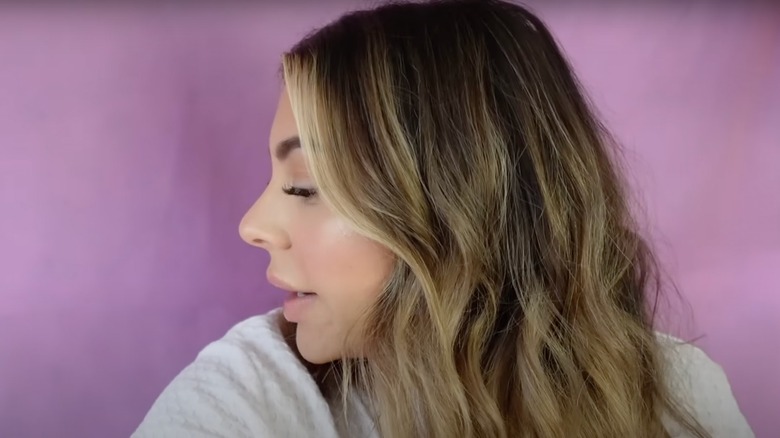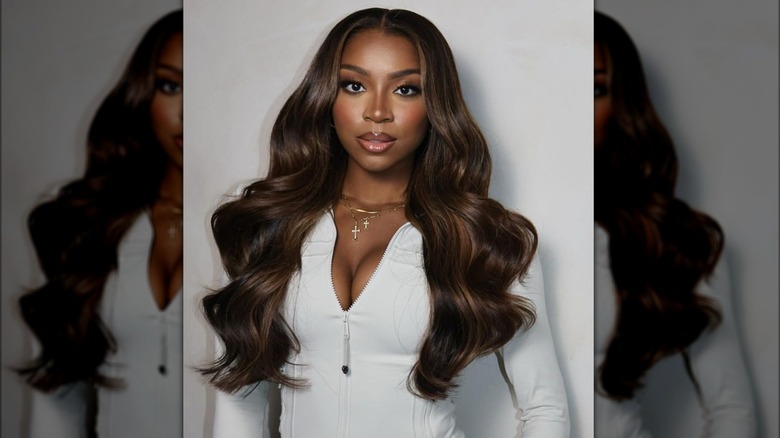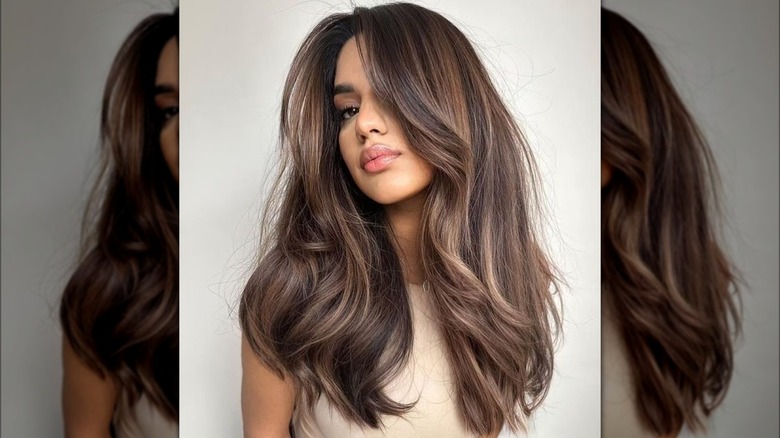What's A Reverse Balayage? All The Info On The Low-Maintenance Hair Trend
If you love a low-maintenance hair color that's rich in dimension and depth, then a reverse balayage might be your best bet. Similar to regular balayage, the technique is a free painting style of hair dye application that looks natural and grows out easier than traditional foil highlights. However, while traditional balayage focuses on providing a lightening effect, reverse balayage relies on darker colors to create movement and volume through deeper tones. The style is particularly popular amongst lighter blondes who want to edge into the brunette world for the winter, which makes perfect sense. We tend to crave richer, deeper shades in the winter when it comes to our locks; that's why sumptuous, spicy, decadent tones, like chai blonde hair and reverse balayage, are such favorites during colder months.
"Reverse balayage adds depth back at the root," hair colorist Lauren Grummel told Glamour. "It lowers the contrast between highlights and root color, and pops the rest of the highlights." The focus of a reverse balayage is all about the sumptuousness that comes from the rich, chocolate tones, rather than the lighter colors. So for anyone who wants to take blonde hair and make it winterized, reverse balayage is the style for you.
What to ask for and what to expect with a reverse balayage
The perk of reverse balayage is that it's a subtle, natural difference that you decide on with your stylist. "The idea is to blend the client's natural color, or a tone that you and your colorist agree upon, into previously highlighted hair to create a melted, gradient look from root to ends," colorist Giancarlo Carollo told PopSugar. Some stylists may approach this by creating balayage highlights toward the middle and adding shadow roots. Others may go the route of lightening the roots to a shade that's just a bit darker than the highlighted portions, but still lighter than the natural hair color.
For this reason, many stylists suggest that clients book a consultation appointment first to discuss your color goals. It's especially helpful to bring in images of what you want to serve as a visual guide, so that the dark tones aren't too dark for what you're expecting.
Rest assured that your stylist will get into it. Hair colorist Bianca Hillier told Glamour that she's a huge fan of the process. "I love the lived-in and grungier feel of the reverse balayage," Hillier said. "Something with depth always feels more realistic." The best thing you can expect with a reverse balayage is how easy and low-maintenance it is. The grow-out process is stress free, since your roots will blend perfectly with the dark tones.
Who looks good with a reverse balayage?
The easy answer is that everybody looks good with a reverse balayage! For natural blondes, reverse balayage will be a welcome change in the winter. For those who are working with highlights or a traditional balayage, a reverse balayage will be a fun way to add a little depth to the hair and return to the realm of the brunette. While you'll certainly leave the salon darker, reverse balayage is meant to be subtle, just as traditional balayage is meant to discreetly brighten the hair. "Balayage gives softer, less noticeable regrowth lines with the principal idea being less is more," hair colorist Jack Howard told PopSugar. So a big part of the appeal is that reverse balayage is more natural looking option than going fully dark if you're craving something richer. Afterall, the point of reverse balayage is that the change is happening under the hair. "It's all about lowlights and tone, and adding contrast with darker, shadowy pieces underneath," colorist Mark DeBolt told Byrdie.
Besides a change in color, reverse balayage is a great option for everyone. For straight, curly, and coily hair, reverse balayage is a brilliant way to match your look to the darker, shorter winter months when we want to cozy up and embrace a richer palette.
Grow out and care of a reverse balayage
Perhaps the best part of a reverse balayage is how easy the grow-out process is. Natural regrowth is no problem whatsoever, since you're adding darker tones rather than lighter ones. You likely won't need to touch up the color for at least six to eight weeks, and even then, you could probably go longer. "It's just low-maintenance," colorist Rita Hazan told Byrdie. "It should help your natural hair blend better with your new color."
Hair colorist Bianca Hillier suggested to Glamour that clients get an Olaplex treatment to take care of hair after getting treatments. It's also a really good idea to take care of treated hair at home, by using a color treated shampoo and conditioner.


